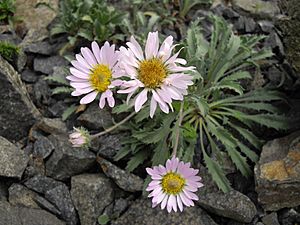Xanthisma coloradoense facts for kids
Quick facts for kids Xanthisma coloradoense |
|
|---|---|
 |
|
| Conservation status | |
| Scientific classification | |
| Kingdom: | |
| (unranked): | |
| (unranked): | |
| (unranked): | |
| Order: | |
| Family: | |
| Tribe: |
Astereae
|
| Genus: | |
| Species: |
X. coloradoense
|
| Binomial name | |
| Xanthisma coloradoense (A.Gray) D.R.Morgan & R.L.Hartman
|
|
Xanthisma coloradoense, also known as the Colorado tansyaster, is a beautiful flowering plant. It belongs to the aster family, which includes many well-known flowers like sunflowers and daisies. This plant grows naturally in the mountains of Colorado and Wyoming in the United States. It's sometimes called a cushion plant because it often grows in a low, compact shape, like a small cushion on the ground.
Contents
Colorado Tansyaster: A Mountain Flower
What Does This Plant Look Like?
The Colorado tansyaster is a perennial herb. This means it lives for more than two years. It grows from a deep taproot (a main root that grows straight down) and a branching caudex (a short, woody stem base). This plant can grow up to 14 centimeters (about 5.5 inches) tall. It has several thick, hairy stems.
Its leaves are also hairy. They are shaped like a lance or a spatula. The edges of the leaves have large, sharp teeth. These teeth often have tiny bristles at their tips.
Its Unique Flowers
The plant produces a single flower head at the top of each stem. This flower head looks like one big flower, but it's actually made of many tiny flowers. The outside of the flower head has narrow, white-tipped phyllaries. These are like small, leaf-like structures that protect the flower bud.
Inside the flower head, you'll find two types of tiny flowers. There are pink or purple ray florets. These are the petal-like parts that spread out. They can be up to 1.5 centimeters long. In the center, there are many disc florets. These are the small, tightly packed flowers that form the "eye" of the daisy-like head. After the flower blooms, it produces a fruit. This fruit can be almost a centimeter long, including its pappus. The pappus is a feathery or bristly structure that helps the seed fly away in the wind.
Where Does the Colorado Tansyaster Grow?
This plant loves to grow in the mountains. It often lives in an alpine climate. This means it grows in very cold, high-altitude areas. You can find it in different types of habitats. These include grasslands, pinyon-juniper woodlands, and alpine fellfields. Fellfields are rocky areas with very little soil or plant cover.
The Colorado tansyaster prefers open spaces. It often grows where there isn't much other plant life. The ground is usually rocky. Other plants that might grow nearby include pines (Pinus species) and shrubs like Cercocarpus montanus and Chrysothamnus species. You might also see other plants like Astragalus species, Erigeron species, Potentilla species, Festuca species, and Elymus species. Even lichens, like those from the genus Xanthoparmelia, can be found with it. Sometimes, it grows near other rare plants, such as Astragalus molybdenus.
What Challenges Does This Plant Face?
Scientists are still learning about the Colorado tansyaster. Because it hasn't been studied a lot, we don't fully know all the things that might harm it. However, some possible threats have been identified. These include outdoor activities like using off-road vehicles. These vehicles can damage the plant's habitat.
Other potential problems include invasive species. These are plants or animals that are not native to the area and can take over. Grazing and trampling by farm animals like livestock can also hurt the plants. Finally, energy development, especially wind power projects, could affect where this plant lives. More research is needed to understand how to best protect this unique mountain flower.


